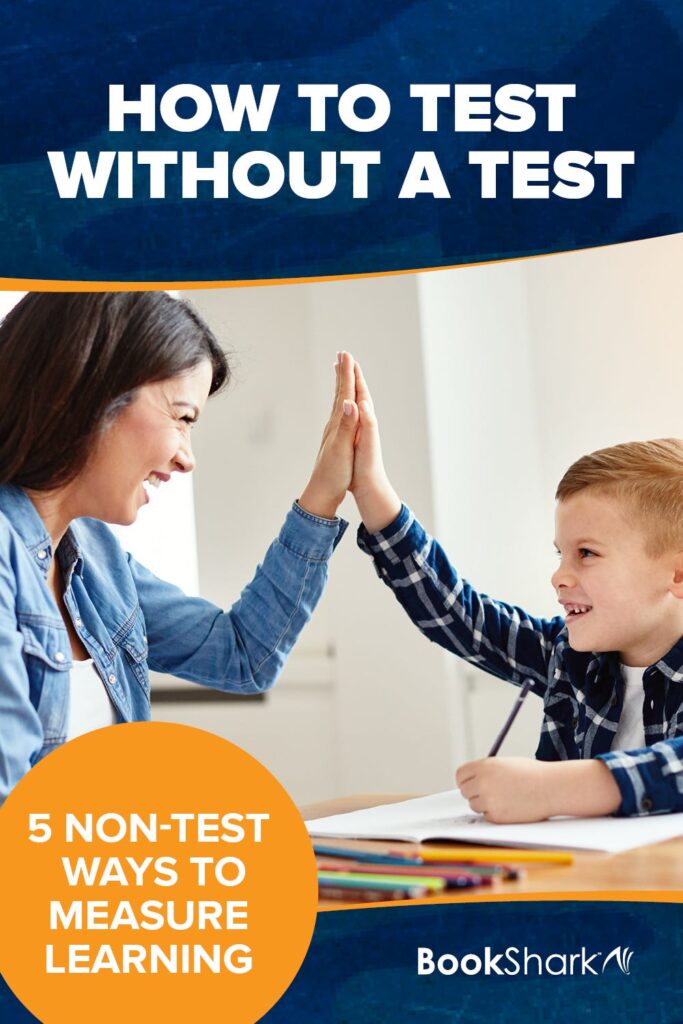




How to Test Without a Test

We all can recall that feeling from our days in public school when the teacher distributed a test full of letters to be circled and blanks to be filled in. Our sharp pencils would start to tap on our desks as we tried to recall something—anything—about what we had crammed the night before, but it’s gone. We draw nothing but blanks.
We carefully read and reread the questions, maybe ruling out a C here or a D there and making our best guess between A and B. When the test is mostly filled in, we hand it in, hope for a passing grade, and it’s on to the next chapter in the textbook to repeat the cycle again next week.
These icky memories of tests are why I’ve never been a traditional test-giver as a homeschool mom.
I know that my soon-to-be high schooler will need to have testing skills eventually, and we will work on that as it comes, but for younger kids, especially kids who stress out easily, paper tests can be the straw that breaks a love of learning for your child.
As parents though, we want to make sure the things we’ve spent hours teaching our children has stuck with them. For that reason, I want to test my kids but not with tests in the conventional sense. Here are non-test ways I use to gauge a child’s learning without completely stressing them out.
Presentation
At the end of a unit or section, have your child prepare a presentation to give to the family. Invite the grandparents over to make it more official. Give them a short list of things from their Science or History lessons that you’d like them to prepare, for example, recite a part of a speech or create and explain a model of a battle. Set a date for the presentation and have them work a little bit on it daily until it’s ready.
Oral or Written Report

Writing a report, whether it’s several pages or just a drawing that your child talks about is a great way to see all your child has learned. There are lots of ways to do a report.
- Have them type a traditional research paper based on what you’ve studied together.
- Create a lap book. (BookShark has kits right here.)
- Cover an empty cereal box in construction paper, then print pictures, write out information, and draw maps and cover all the sides of the box with information.
Skit
Have your children choose roles to play based on things you studied and write out their own skit. Have a lot of it be ad lib, because then you’ll know it’s not just memorized to get through the skit. Have them create costumes and a simple setting. When my kids acted out a scene about Alexander the Great and his parents, I saw exactly what they learned about him in a playful, no-stress way.
News Show
Put on one of dad’s ties, set up a desk, give your child a coffee cup, and have them play newscaster for an evening news show. In advance, have your child write out what he’ll talk about on the news. Makes sure he adds in lots of facts and details. It could be all about a new science discovery or ways to do long and short division or a battle in a war in history —anything you’ve studied in homeschool. Just pretend he’s saying it on the news!
Dinner Party
I love tying up a unit study with a great dinner party. Plan a dinner based on a time in history or a fun science theme you’ve been learning about. Gather supplies from around the house and let your child take the reigns. Cook food together, let him decorate, and allow him to have talking points throughout the dinner about things he’s learned. Have him share these facts with the guests at dinner. He’ll love showing off what he knows.
There’s more than one way to make sure your child is retaining what you’ve taught. Pay attention to how your child learns and what makes them tick and what makes them shut down and use those clues to figure out creative ways to test them. You’re going to learn so much together!
